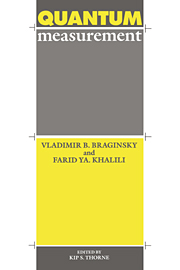
-
Select format
-
- Publisher:
- Cambridge University Press
- Publication date:
- December 2009
- September 1992
- ISBN:
- 9780511622748
- 9780521419284
- 9780521484138
- Dimensions:
- (228 x 152 mm)
- Weight & Pages:
- 0.432kg, 212 Pages
- Dimensions:
- (228 x 152 mm)
- Weight & Pages:
- 0.35kg, 212 Pages
You may already have access via personal or institutional login
Book description
This book is an up-to-date introduction to the quantum theory of measurement, a fast developing field of intense current interest to scientists and engineers for its potential high technology applications. It is also a subject of importance to students for its central role in the foundations of quantum mechanics. Although the main principles of the field were elaborated in the 1930s by Bohr, Schrödinger, Heisenberg, von Neumann and Mandelstam, it was not until the 1980s that technology became sufficiently advanced to allow its application in real experiments. Quantum measurement is now central to many ultra-high technology developments, such as squeezed light, single atom traps, and searches for gravitational radiation. It is also considered to have great promise for computer science and engineering, particularly for its applications in information processing and transfer. The book contains a pedagogical introduction to the relevant theory written at a level accessible to those with only a modest background in quantum mechanics. It then goes on to discuss aspects of the design of practical quantum measurement systems. This book is essential reading for all scientists and engineers interested in the potential applications of technology near the quantum limit. It will also serve as an ideal supplement to standard quantum mechanics textbooks at the advanced undergraduate or graduate level.
Reviews
‘ … applies all tools of classical and quantum measurement to the measurement of small forces. The tools include evolution operators, eigenstates, density matrices, correlation functions, noise spectral densities and hetero- and homodyne detection … the ideas, all subtle, fundamental and useful, are the original work of the authors … will provide easy-to-understand examples for the quantum mechanics texts of the future, and it will influence the direction of research in quantum mechanics.’
Donald Searl Source: Physics Today
Contents
Metrics
Altmetric attention score
Full text views
Full text views help Loading metrics...
Loading metrics...
* Views captured on Cambridge Core between #date#. This data will be updated every 24 hours.
Usage data cannot currently be displayed.
Accessibility standard: Unknown
Why this information is here
This section outlines the accessibility features of this content - including support for screen readers, full keyboard navigation and high-contrast display options. This may not be relevant for you.
Accessibility Information
Accessibility compliance for the PDF of this book is currently unknown and may be updated in the future.


